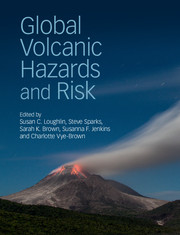12 results
Barriers to and solutions for representative inclusion across the lifespan and in life course research: The need for structural competency highlighted by the COVID-19 pandemic
-
- Journal:
- Journal of Clinical and Translational Science / Volume 7 / Issue 1 / 2023
- Published online by Cambridge University Press:
- 06 December 2022, e38
-
- Article
-
- You have access
- Open access
- HTML
- Export citation
List of Contributors
-
- Book:
- Global Volcanic Hazards and Risk
- Published online:
- 05 August 2015
- Print publication:
- 24 July 2015, pp viii-ix
-
- Chapter
-
- You have access
- Open access
- Export citation
Frontmatter
-
- Book:
- Global Volcanic Hazards and Risk
- Published online:
- 05 August 2015
- Print publication:
- 24 July 2015, pp i-iv
-
- Chapter
-
- You have access
- Open access
- Export citation
Contents
-
- Book:
- Global Volcanic Hazards and Risk
- Published online:
- 05 August 2015
- Print publication:
- 24 July 2015, pp v-vii
-
- Chapter
-
- You have access
- Open access
- Export citation
Online Appendix B - part 1 (low res)
-
- Book:
- Global Volcanic Hazards and Risk
- Published online:
- 05 August 2015
- Print publication:
- 24 July 2015, pp 411-816
-
- Chapter
-
- You have access
- Open access
- Export citation

Global Volcanic Hazards and Risk
-
- Published online:
- 05 August 2015
- Print publication:
- 24 July 2015
-
- Book
-
- You have access
- Open access
- Export citation
Index
-
- Book:
- Global Volcanic Hazards and Risk
- Published online:
- 05 August 2015
- Print publication:
- 24 July 2015, pp 389-393
-
- Chapter
-
- You have access
- Open access
- Export citation
Acknowledgements
-
- Book:
- Global Volcanic Hazards and Risk
- Published online:
- 05 August 2015
- Print publication:
- 24 July 2015, pp xiv-xiv
-
- Chapter
-
- You have access
- Open access
- Export citation
Online Appendix B - part 2 (low res)
-
- Book:
- Global Volcanic Hazards and Risk
- Published online:
- 05 August 2015
- Print publication:
- 24 July 2015, pp 817-1208
-
- Chapter
-
- You have access
- Open access
- Export citation
Preface
-
- Book:
- Global Volcanic Hazards and Risk
- Published online:
- 05 August 2015
- Print publication:
- 24 July 2015, pp xii-xiii
-
- Chapter
-
- You have access
- Open access
- Export citation
Online Appendix A
-
- Book:
- Global Volcanic Hazards and Risk
- Published online:
- 05 August 2015
- Print publication:
- 24 July 2015, pp 394-410
-
- Chapter
-
- You have access
- Open access
- Export citation
Foreword
-
- Book:
- Global Volcanic Hazards and Risk
- Published online:
- 05 August 2015
- Print publication:
- 24 July 2015, pp x-xi
-
- Chapter
-
- You have access
- Open access
- Export citation

